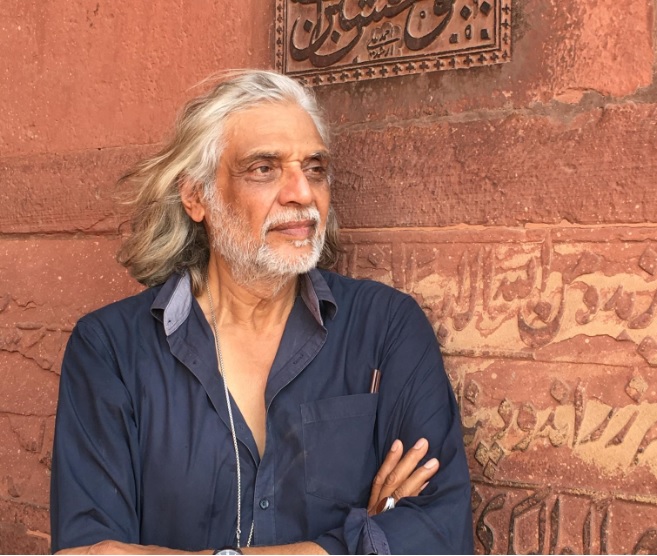Welcome to Samvaad, where art meets conversation, and inspiration knows no bounds. Here we engage in insightful conversations with eminent personalities from the art fraternity. Through Samvaad, Abir Pothi aims to create a platform for thought-provoking discussions, providing readers with an exclusive glimpse into the creative processes, inspirations, and experiences of these creative individuals. From curating groundbreaking exhibitions to pushing the boundaries of artistic expression, our interviews shed light on the diverse perspectives and contributions of these art luminaries. Samvaad is your ticket to connect with the visionaries who breathe life into the art world, offering unique insights and behind-the-scenes glimpses into their fascinating journeys.
In this episode of Samvaad, we have the privilege of sitting down with Ashish Agarwal, founder of Ashish Agarwal Interiors, a purpose-driven interior design firm based in Guwahati, Assam. Specialising in residential, commercial, retail, and office spaces of varying sizes, their portfolio reflects a commitment to creating environments that evoke human emotions and foster a sense of belongingness. From multinational corporations seeking growth-driven atmospheres to individuals envisioning their dream homes, Ashish Agarwal Interiors caters to a diverse clientele with meticulous attention to detail. Joining us for this insightful conversation is Nidheesh Tyagi from Abir Pothi, as we uncover the visionary insights driving the creative force behind Ashish Agarwal Interiors, shaping the landscapes of tomorrow. Please do check Part-2 (Click Here)
Nidheesh: How do you experience art, like when you’re in a gallery or when you’re in Europe? What is your process of experiencing art?
Ashish: Well, art for me is, of course, a very different experience and it’s an expression of a person who creates it. I try to understand it with the perspective the artist has in creating that art. Art could be in different forms as well. I feel anything which is kept aesthetically is also art for me. If you keep this book like this and I just put it like this, it becomes art for me. So, art has a lot to do with aesthetics as well. There’s colour to it, there’s a size to it. In designing, I take a lot of care that I have a very designated space for my art pieces. If that art is not installed, the design is not complete. For me, art is, of course, a very personal interpretation. But when I perceive my design in my mind, I always have art coming to my imagination, without which I can’t do. It could be oil, it could be canvas, it could be craft, it could be mural, or just bringing a few objects together, and it’s art for me.
Nidheesh: You visualise when you design, and you think art is an integral part of it. But how do you tell your clients that this is so pivotal or important for them to consider having art in that place?
Ashish: well this is the most pain area which you have touched Nidheesh and I’m sure most of the designers across the world I don’t know about others but especially in India it is a very difficult situation where we have to convince our client that you need this out of this wall so over a period of time I’ve realized that you know this is one area which is going to be hampered the entire project is not complete so I try to understand the depth of it how do we go about it so few things which I’ve been doing is that uh right from the beginning we start establishing that importance of of art to a client we give examples like when you wear a suit and if you don’t have accessories on it it is your dress is not complete so architecture is more about functionality the purpose and and you know so many functions it has to perform but the the the thought provoking emotions cannot be done through architecture so where does it come from we try and give consultation to the people or to the client we educate them towards the art it is a good effort which is required from all the designers and we we feel that it’s not our job but that it’s high time that we realize it is core part of Designing so I have changed my mindset I made it a point that I’m going to talk about art in every project I’m going to do and also I worked towards the kind of resources I need to bring those art come in place so that they don’t feel like aliens have to oh my God I have to deal with art who is going to do it for me where is it going to come from how is going to be priced so right from the budget to the aesthetic we give a very important give a lot of importance to the art part of the project so we ask them to keep a seperate budget we we designed our entire flow of architecture the processes and the last is finishing an art Furnishing and art so they they they are mentally prepared is going to come in the last and we can’t run away from it so that is one approach we’ve been taking
Nidheesh: So, tell us about the art which blew your mind.
Ashish: Well, art is going to blow you away. People who don’t accept this line, I’m saying, I would say they’re lying. It is going to provoke your thoughts, it is going to touch your emotions, and it is going to give you a different way of looking at things. Imagine a blank black wall, and just put a small piece of art; your thoughts are going to multiply at that point in time. So, how can someone ignore art?
It was one experience which I had when I travelled to Amsterdam. I was not aware of the city, or what it was going to offer me. I was not theoretically seeing art or intentionally, you can say. It happened that I visited the Museum of Van Gogh, the famous legendary artist. When I learned about the kind of painting he did, any creative person has a very wild thought process which keeps on going in their mind, any creative field for that matter. I had a certain kind of connection with this person when I went to the museum and saw his art – there’s a twisted and turmoil, two faces which have converted like that. I sat inside the museum for hours and just tried to understand what was the thinking process which was going behind this, and I was able to resonate with it at some point in time, the kind of work I wanted to do, the amount of work I wanted to do in such a small time. I had some connection, so that inspired me to a different zone, I would say. I was in a different zone, and that moment keeps inspiring me today as well. So, I think Van Gogh was one guy who inspired me every day.
Nidheesh: So, as a practising designer, can I ask you, Abir, Pothi has loads of followers, you know, young artists who are just beginning their practices. Abir India is also like a foundation that kind of creates, and grooms loads of young artists from the Hinterland. Largely, what do you tell the young artists, architects, and designers about, you know, who are now coming into the fold and talking about how they take their work journeys from there?
Ashish: I feel artists should travel a lot. For me, travelling was the biggest exposure I got through, and travelling is something which keeps on inspiring you. Even if you travel once in a year or once in five years, it is going to make you think over a period of time, and you interpret it every time differently. So for an artist, I would say, travel, go to places, and see different design languages in terms of architecture, handicrafts, art, and even performing art. So, from history, there’s a lot of inspiration, and if you look at any art form, it keeps on evolving. If you try to understand the route where it started and where it is coming, I think it’s going to give a lot of different perspectives about art. And art is also related to architecture, as we all know. Both have inspiration, of course, the purposes are different, but then having a dialogue with architects, because architects also talk about a lot of wild imagination, you know, they have because of the functionality and other constraints they cannot express the way they think.
Nidheesh: They might be thinking of 100 things, but they can only do one or two of them in India.
Ashish: So I would say, talk to architects, go to The Forum, understand their imagination, pick up ideas from there, and express to art. There could be a fruitful blend of art, and architecture, and it’s going, basically, we are going to inspire each other. There have been, uh, the kind of interaction which should be there in India is not happening. I’ve been travelling to all the major cities, I’ve been seeing those, mostly art is missing there. One incident in Ahmedabad was there last year. There was a hardware merchant exhibition. Most of these merchants were just showcasing the hardware, the furniture hardware which Gujarat is, you know, leading in manufacturing. And this organization, they took an effort and brought those rural artists and gave them space to put their art. It was more towards, you know, bringing uplift to them and bring them to the main platform. So that is a great move, a great gesture where, you know, people are already, uh, splitting their wings into different states and different areas and trying to bring those artists and give them a main platform. I think those kinds of activities are required. I mean, people already have a lot of approaches, should encourage more artists to come forward, handhold them, and, you know, bring them more exposure. That is one thing I think is a great way.
Was Guwahati Ready for Retail Design? Ashish Agarwal’s Journey Proclaims the Answer (Part-1)





